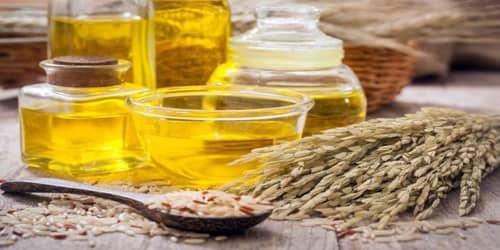Rice Bran Oil
Introduction: Rice bran oil is an increasingly popular vegetable oil that offers many advantages over standard vegetable oils that millions of people commonly cook with all over the world. It is the outer brown layer of the rice grain. The basic components of a paddy grain are shown below: It contains fiber, lipids, amino acids as well as a variety of vitamins and minerals. This nutritionally rich bran is produced when rice is milled. The oil extracted from this bran is called rice bran oil. Although whole rice bran in itself does not have anti-cholesterol properties, its oil offers significant benefits.
Rice bran oil is known for its high smoke point of 232 °C (450 °F) and mild flavor, making it suitable for high-temperature cooking methods such as stir frying and deep frying. It is popular as cooking oil in several Asian countries, including Bangladesh, Japan, India, and China.
Rice bran is used for treating diabetes, high blood pressure, high cholesterol, alcoholism, obesity, and AIDS; for preventing stomach and colon cancer; for preventing heart and blood vessel (cardiovascular) disease; for strengthening the immune system; for increasing energy and improving athletic performance; for improving liver function; and as an antioxidant.
Rice bran oil is also used for high cholesterol.
The Composition of Rice Bran Oil: Rice bran oil has a composition similar to that of peanut oil, with 38% monounsaturated, 37% polyunsaturated, and 25% saturated fatty acids. Physically Refined RBO also contains high amounts of γ-Oryzanol, which has been proven to reduce the level of blood cholesterol by many studies. Chemical refining takes away much of this nutraceutical.
Key chemical characteristics of RBO produced at our plant are given below:
- PUFA 34%
- MUFA 44%
- SFA 22%
- Trans Fats Nil
- γ-Oryzanol 10,000 – 14,000 ppm
- Free Fatty Acid (% as oleic) 0.1% max
- Color (1″ cell, Lovibond 5R+Y) 12.0 max
- Iodine Value (Wijs method, g/100 g sample) 91–98
- Peroxide Value (meq/kg) 1.0 max
- Saponification Value 180–185
- Unsaponifiable Matter 3.5 max
- Refractive Index 1.464–1.465
- Specific Gravity 0.917
- Para Anisidine Value 55 max
- Smoke Point 255 Deg. Cels.
- Moisture (%) 0.05% max

Uses and Benefits of Rice bran oil: Rice bran oil is most commonly used in Asian cultures, including Japan and China, primarily because rice is already a staple food in their cuisines. However, rice bran oil is becoming increasingly popular in other parts of the world because of its relatively low price point and the many health benefits that come from using it in food preparation.
Rice bran might help lower cholesterol because the oil it contains has substances that might decrease cholesterol absorption and increase cholesterol elimination. One of the substances in rice bran might decrease calcium absorption; this might help reduce the formation of certain types of kidney stones.
Rice bran oil has various health benefits as mentioned below.
- Cholesterol – Literature review shows rice bran oil and its active constituents improve blood cholesterol by reducing total plasma cholesterol and triglycerides, and increasing the proportion of HDL cholesterol. Results of an animal study indicated a 42% decrease in total cholesterol with a 62% drop in LDL cholesterol when researchers supplemented test subjects’ diets with fractionated vitamin E obtained from rice bran oil.
- Prevents Menopausal Issues – Research has been conducted on an extract of rice bran oil in terms of how it affects menopausal women. More than 90% of the women who took the supplement reported a reduction in hot flashes and other irritating symptoms of menopause that all women eventually suffer from. The same benefits are suggested by women using rice bran oil on their own as well.
- Heart Friendly – It is known as the heart-friendly oil. “Rice bran might help lower cholesterol because it contains the right amount of oryzanol which is an antioxidant. It helps decrease cholesterol absorption and increase cholesterol elimination.
- Has a High Smoke Point – Rice bran oil has a high smoke point, which is pitched at 254C or 490F, which makes it perfect for stir-frying or deep frying. It can maintain its nutritive quality even at high temperatures. Also, it has been seen that food cooked at high temperatures absorbs less oil.
- Insulin resistance – In utero exposure to germinated brown rice and its oryzanol-rich extract attenuated high fat diet-induced insulin resistance in rats.
- Prevents Allergic Reactions – Rice bran oil is hypoallergenic in nature. The oil will not cause any allergic reactions when used in cooking, and can also calm existing allergic reaction in the body. It can also prevent hypersensitivity to other unusual allergens.
- Aids Weight Loss – It contains high levels of natural antioxidants which boost people’s metabolic rate and may help with weight loss. The high level of antioxidants not only makes this oil healthy but also makes it resist rancidity and spoilage. It has a long shelf life.
- Good for the Skin – Squalene is a compound present in Rice Bran Oil which is easily absorbed by the skin and keeps it soft, supple and smooth.
Rice bran oil is high in fiber, which can improve digestion unless people have an existing gastrointestinal condition. The fiber can block up the gastrointestinal tract further if people are already suffering from ulcers or any other condition that narrows their digestive tract for any reason. Furthermore, be careful about the amount of rice bran oil people consume, as it is high in calories.
Information Source:
















